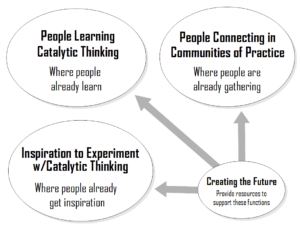Creating the Future is at a crossroads. And we are so excited about stepping into what’s next!
That’s because implementing our next steps will not be done by us – it will be done by, well, everyone! Moving beyond the organization-centric model that tells each organization to excel on its own, we will be doing just the opposite. Our goal is simple:
We don’t want to be needed. We want our mission to be accomplished.
We want to create space for others to step into.
And we will be working aggressively towards that.
Here’s our story:
Last year, we asked our community to determine the direction we will take in the 2nd half of our 10-year mission. If you are the ones who will be affected by our work, shouldn’t it be up to you to decide what we prioritize and take action on?
In our first 5 years, we applied Catalytic Thinking in a wide variety of settings, exploring the power of the framework to create systemic change. In this next phase of our mission, our work is to share the framework – and what we’ve learned about it from those experiments – as broadly as possible… to make Catalytic Thinking ubiquitous.
In last year’s extensive conversations with our community, you told us that your highest aspiration for our work is a global mind-shift:
- From reacting to what’s wrong, to creating what is possible
- From reacting to the worst in each other to bringing out the best in each other
- From going it alone to the power of Collective Enoughness, sharing and building upon each other’s strengths
You then told us what needs to be in place for that mind-shift to happen:
- Places to learn Catalytic Thinking
- Places to gather together with other Catalytic Thinking practitioners
- The inspiration to experiment with different ways of being in our work and in our lives
Our work is now all about implementing those goals – making things happen. That leads to more questions:
What will accomplish the goal of making Catalytic Thinking ubiquitous, and our community’s goal for that mind-shift, within the parameters of our values? What do people need, to make Catalytic Thinking their own?
Having committed to accomplishing our mission within a 10-year timeframe, what approach will best accomplish that?
If the organization-centric norm of work in the social change arena is actually a remnant from the business world and the military (both places of power and privilege) – and we’ve already explored what a more democratic, participatory approach would look like in decision-making – what could that participatory approach look like for implementation – the work itself?
Here is what we’ll be doing to answer these questions – the next experiment, our biggest experiment so far – and perhaps our final one.
Not surprisingly, the answer is rooted in Catalytic Thinking, and in particular, Collective Enoughness – the economic principle that together we have everything we need.
Meet People Where They Are
If folks have to come to our organization to learn, connect, and/or be inspired, then Catalytic Thinking will never be ubiquitous.
If, on the other hand, it is important that EVERYONE have access to that knowledge and connection, then that benefit cannot be centered at Creating the Future.
It must instead be accessible wherever people are already learning, already gathering, and already being inspired – the literal meaning of “meeting people where they are.”
If we want the results of our work to be incorporated into people’s daily lives, then the work of sharing and connecting and inspiring has to be incorporated into their lives as well. The process of doing the work must itself exemplify the results we want to see!
What that means in practice is moving AWAY from the organization-centric norms in the social change arena. Instead we will accomplish this goal by embodying the spirit of mutual aid that is at the heart of Collective Enoughness – create space for others to step in with their own gifts, their own wisdom, their own brilliance.
Of all the tasks that need to be done to accomplish our goal – teaching, convening, inspiring – who is already doing that work? And what would make it easy for those individuals to share Catalytic Thinking as part of what they’re already doing?
Here is what we are therefore about to begin, to put this Collective Enoughness approach into practice:
- People will be able to learn Catalytic Thinking wherever they are already learning. That could be high school or university classes, or adult learning settings. It could be capacity building entities (including consultants), or it could be simply from conversations with other people who are already using the framework.
Our next steps will therefore be to identify people or groups who are teaching in those settings, and to develop resources to support them to teach Catalytic Thinking as it relates to their own subject matter.
- People will be able to connect with other practitioners wherever they are already gathering. That could be classrooms or within organizations. It could be coalitions and affinity groups. Or again, it could be simply from conversations with other people who are already using the framework.
Our next steps will therefore be to identify people or groups who are already bringing people together in those settings, and to develop resources to support them to convene their own communities of practice around Catalytic Thinking.
- People will be inspired to experiment wherever they are already getting their inspiration. That could be from print media or online media. It could be podcasts, newsletters, blogs, social media posts. Or again, it could simply be from conversations with other people who are already experimenting with the framework.
Our next steps will therefore be to identify people who are already blogging, podcasting, and sharing information and inspiration, and to provide content that they can share about the power of Catalytic Thinking.

Just as we asked our community to lead the direction we will take for accomplishing our mission, this next step will share the work of turning that general direction into action.
Because this will be an emerging process, we know that we will learn what is needed as we go along. We also know that we will be sharing what we learn along the way about this whole process, so that other organizations can explore what might be possible if they were to democratize and decentralize the implementation of their work.
What becomes clear from this approach is that the implementation of our mission doesn’t need to be “officially adopted” by any particular entity or person. It doesn’t require any sort of formal organization-to-organization collaboration, or sanctioning by a foundation or government entity.
That bureaucratized approach goes directly counter to the principles of mutual aid that are embedded in the Catalytic Thinking framework, in the spirit of Collective Enoughness, and in our values at Creating the Future.
To be ubiquitous means that the questions of Catalytic Thinking become an invisible part of the culture – not a slogan or a campaign, but just the way we be, the way we ask questions in our work and in our lives.
And the most logical way for that to happen is to have it happen where people are already learning and coming together.
Imagine the power of taking a mutual aid / Collective Enoughness approach in other organizations, with very different missions. A food bank or domestic violence organization, where their programs are so democratized that people can get help wherever they already are – at work, at their place of worship, at school, in their neighborhood. We are excited to explore what this will look like, for us and potentially for others.
We are confident that this will be a big step towards accomplishing something bigger than any one individual or group could accomplish on their own. If we have done the job of “sharing” well, by the time our 10-year clock rings at the end of 2026, Creating the Future will hopefully no longer be needed.
We will be putting into practice that old proverb we all love to quote but are often uncertain how to do…
“If you want to go fast, go alone. If you want to go far, go together.”
And that may just be Creating the Future’s ultimate experiment.


This makes sense to me — Creating the Future capacitating movements with impactful thinking so they integrate it into the work their are already doing with a wide range of constituencies. It makes even more sense when we acknowledge that movements often think about what we’re doing at the expense of thinking about what we’re thinking. All the best with this!
Thank you for this, Nora! We’re honored and grateful that you have been part of this journey with us. Here’s to what’s next!